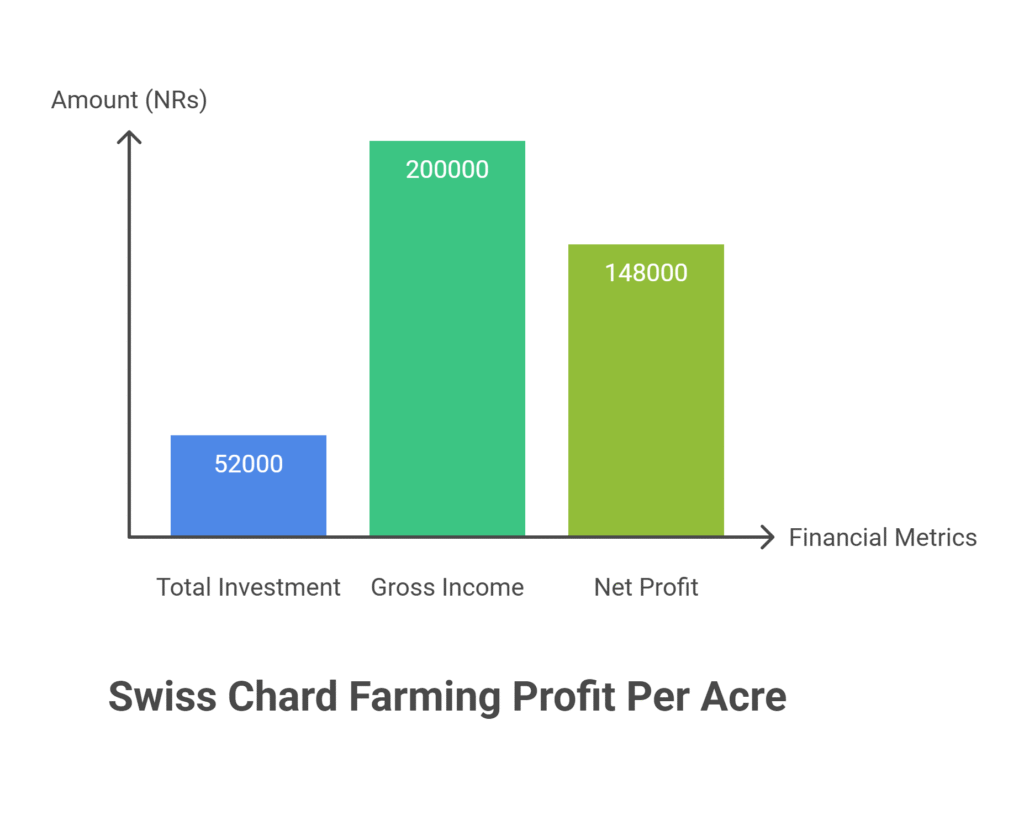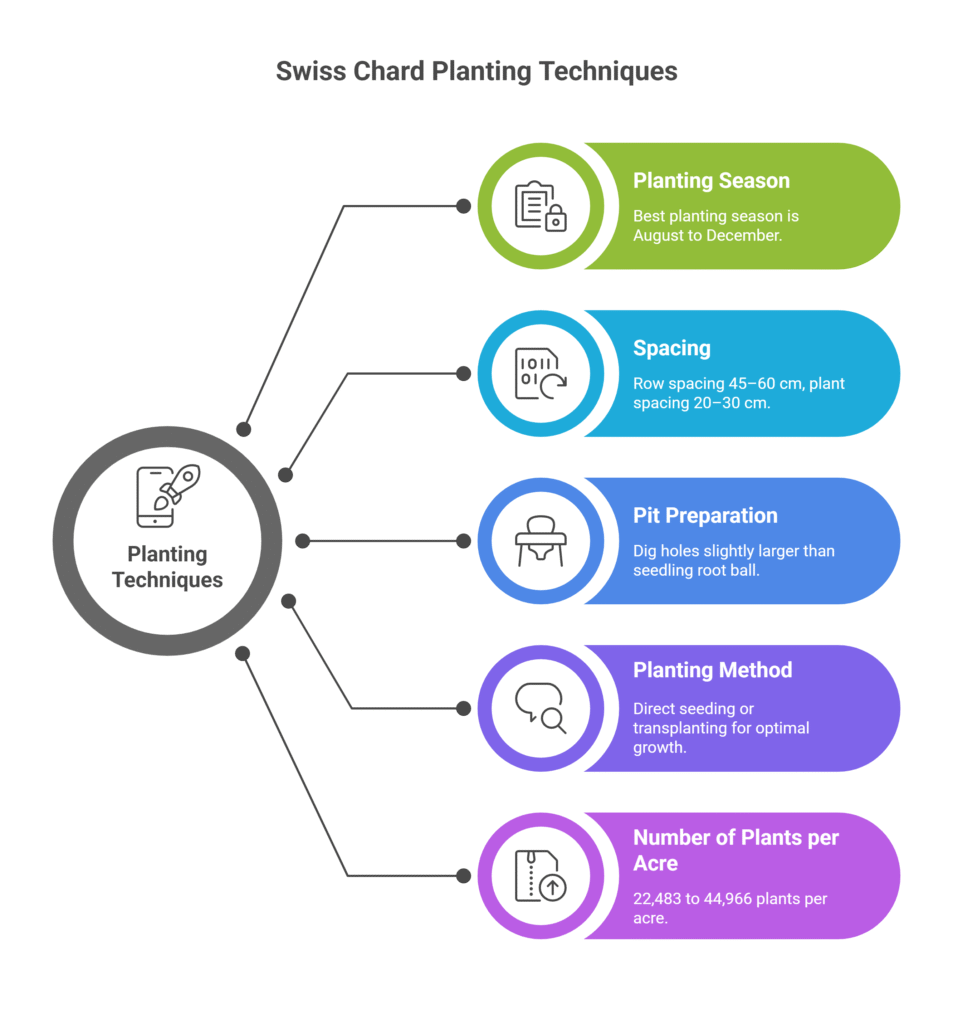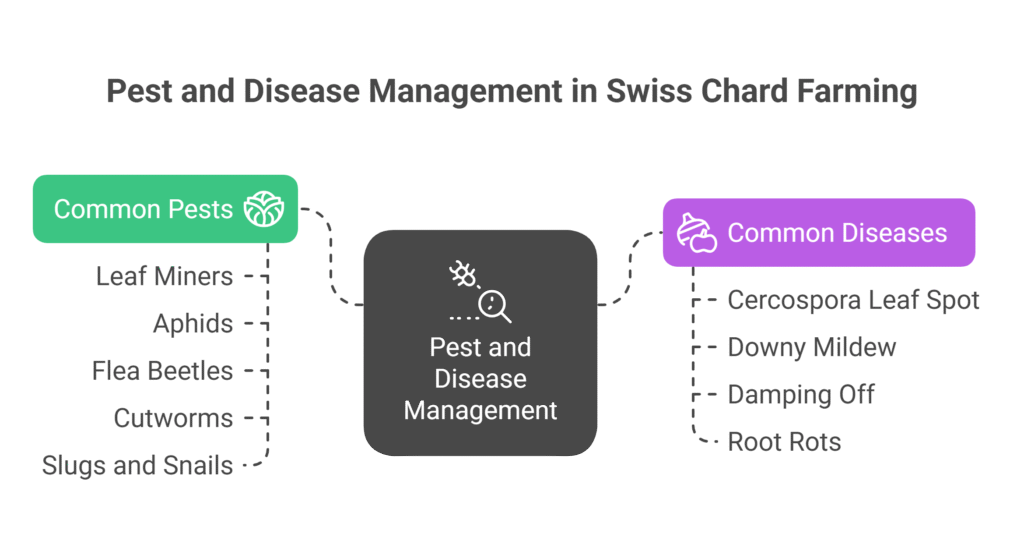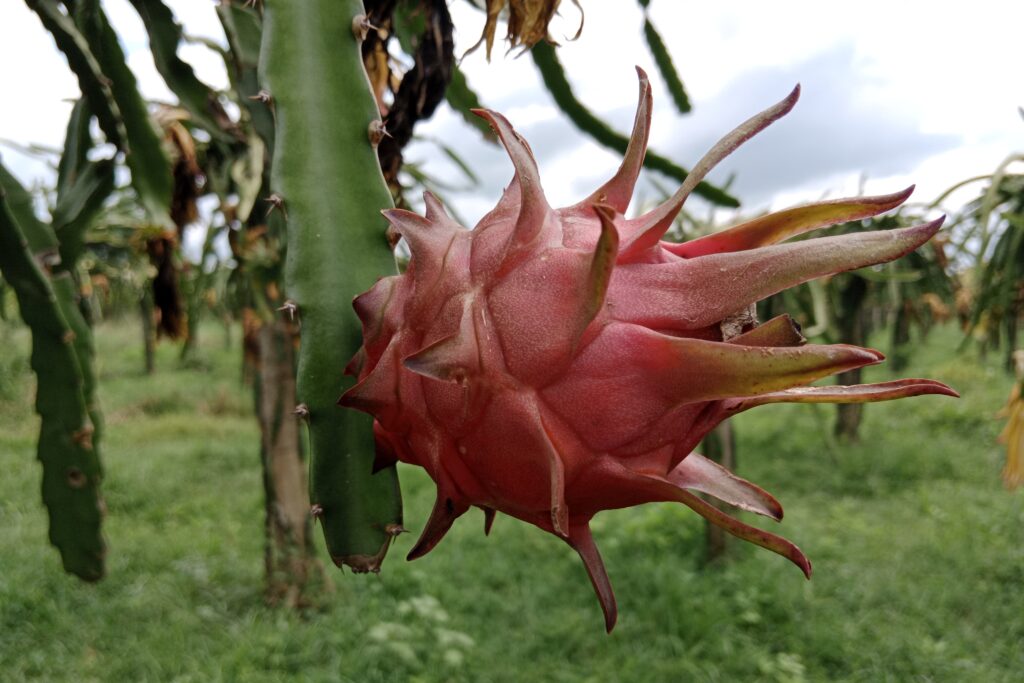Swiss Chard farming
Swiss chard farming is a profitable and low-maintenance venture, adaptable to a variety of climates. This leafy green is highly nutritious, offering abundant vitamins such as A, K, and C, which are essential for vision, blood clotting, and immune system support. Additionally, it contains significant amounts of magnesium and manganese, important for bone strength, enzyme activity, and antioxidant protection, making it both a health-promoting crop and a valuable addition to agricultural production.

Swiss chard farming profit per acre demonstrates remarkable economic viability, as evidenced by a recent cultivation analysis. With a total investment of 52,000 NRs covering land preparation, inputs, and labor, farmers can achieve a yield of 10,000 kg/acre sold at 20 NRs/kg, generating a gross income of 200,000 NRs. This results in a net profit of 148,000 NRs, reflecting a robust 74% profit margin and an exceptional 285% return on investment (ROI). These figures position Swiss chard as a high-value leafy green crop capable of delivering substantial financial returns per acre in sustainable agricultural systems.

Land Preparation
For Swiss chard cultivation, prepare the land by first clearing weeds, crop residues, stones, and other debris from the previous crop. Conduct deep ploughing to a depth of 20–25 cm to break soil compaction, enhance aeration, and incorporate organic matter, which supports healthy root development. Follow this with 2–3 rounds of harrowing to break large soil clods, create a fine tilth, and level the field for uniform irrigation and planting. Finally, form raised beds 15–20 cm high and 1–1.2 m wide to ensure proper drainage in heavy soils or high-rainfall areas, leaving furrows between beds for irrigation and drainage, while flat beds may be used in well-drained soils.
Soil Type
As long as drainage is sufficient, Swiss chard may grow in a variety of soil types, including sandy and clay loams, but it thrives in well-drained, fertile loamy soils that are high in organic matter. Up to pH 7.5–7.8, where vitamin deficits may arise, it can withstand slightly alkaline circumstances, but it prefers the slightly acidic to neutral pH range of 6.0–7.0. A key component is proper drainage because soggy soils can impede plant growth and cause root rot.
Climatic Requirements
Swiss chard is extremely cold-tolerant; established plants can tolerate frosts and light freezes down to -5°C to -7°C (23°F to 19°F). It grows best in cool to moderate temperatures between 15°C and 25°C (59°F and 77°F). Though extended temperatures above 30°C (86°F) may cause bolting, impede development, and lower leaf quality by making them harder and bitter, it can withstand heat better than spinach.
Although it can grow in moderate shade, which is particularly helpful in warmer climates to delay bolting, it likes full sun exposure of 6 to 8 hours each day for best growth and brilliant leaf color. Because the crop needs constant moisture, it is crucial to water it frequently during dry spells to minimize waterlogging and prevent root infections.
Major Cultivars
Swiss chard cultivars are primarily distinguished by stem (petiole) and rib color, and sometimes leaf characteristics:
| Cultivar | Stem (Petiole) Color | Leaf Characteristics | Special Attributes |
| Bright Lights | Mix: yellow, gold, orange, pink, red, white | – | Very popular for visual appeal |
| Rainbow Chard | Vibrant mix (similar to Bright Lights) | – | Often includes diverse vibrant colors |
| Ruby Red / Rhubarb Chard | Deep red | Dark green leaves | Deep red veins |
| Fordhook Giant | Wide white ribs | Large, dark green, crumpled leaves | Very productive; heat-tolerant |
| Lucullus | White | Slightly lighter green than Fordhook | Good bolt resistance |
| Peppermint | Pink and white striped | Green leaves | – |
| Golden Sunrise / Yellow | Bright yellow | – | Yellow veins |
Propagation
Primary Method
Swiss chard is most commonly propagated through direct seeding, which is practical and efficient for most cultivation systems.
Alternative Method
Transplanting from nursery-raised seedlings is also possible, particularly for staggered planting or protected cultivation. However, this method is less frequently used since Swiss chard establishes easily from direct sowing.
Seed Rate per Acre
Seed size and germination rate can influence the actual amount of seed required. Larger seeds or lower germination rates often necessitate a slightly higher seeding rate to achieve the desired plant population. Similarly, higher seeding rates may be preferred for broadcast sowing, where seed placement is less precise, or when environmental conditions are less favorable for germination, to ensure adequate crop establishment.
| Method | Seed Rate per Acre |
| Direct Seeding | 1.5 – 2.5 kg |
| Transplanting (Nursery) | 0.5 – 0.75 kg |
Nursery Management
For transplanting, make raised nursery beds that are approximately 1 m in width, have fine tilth, and add farmyard manure or well-decomposed compost. Plant seeds sparsely in rows 5–7 cm apart, then lightly cover with 0.5–1 cm of dirt. To maintain moisture without waterlogging, water frequently and gently with a misting device or a fine rose can.
Once seedlings have one or two genuine leaves, thin them to a distance of 2.5–4 cm apart to prevent crowding and encourage robust growth. Reduce watering gradually and expose seedlings to full sun and outdoor conditions approximately 5–7 days prior to transplanting. When the seedlings have four to six true leaves and are four to six weeks old, transplant them.
Planting
a). Planting Season
The planting season extends from August to December, though the crop can be cultivated year-round in frost-free regions. However, it is best to avoid peak summer heat for optimal growth and yield.

b). Spacing
For planting, maintain a row spacing of 45–60 cm (18–24 inches) and a plant spacing of 20–30 cm (8–12 inches) within rows for multi-harvest crops.
c). Pit Preparation
For transplanting, dig small holes slightly larger than the seedling root ball at the recommended spacing.
d). Planting Method
Direct Seeding
Direct seeding involves sowing seeds 1–2 cm deep directly into the field at the final spacing. If seeds are sown closer together, thinning is done later to achieve the recommended spacing.
Transplanting
When transplanting, choose seedlings that have been properly hardened off and are ready for field planting. Place each seedling into a prepared hole at the recommended spacing to ensure optimal growth. After planting, carefully firm the soil around the roots to eliminate air gaps, and water right away to reduce transplant shock and promote quick root development.
e). Number of Plants per Acre
Based on the recommended spacing, an acre can accommodate between 22,483 and 44,966 plants.
Intercropping
Swiss chard can be intercropped with compatible plants such as beans, onions, garlic, carrots, radishes, lettuce, brassicas, and certain herbs like dill and mint, which can help deter pests. Incompatible crops include potatoes, corn, and cucurbits like melons, squash, and cucumbers, as they compete heavily for space and nutrients.
Intercropping offers several benefits, including efficient land use, diversified income, pest and disease management through trap cropping or providing habitat for beneficial insects, and improved soil health, especially when legumes are included. Key considerations include avoiding shading of chard, matching water and nutrient requirements among crops, and maintaining easy access for harvesting.
Irrigation
Consistent moisture is essential for Swiss chard to produce tender, non-bitter leaves, so both drought stress and waterlogging should be avoided. Irrigation frequency depends on soil type, temperature, and rainfall, but generally involves 1–2 deep waterings per week, with sandy soils requiring more frequent, lighter irrigation and clay soils needing less frequent but deeper watering.
Critical stages for watering include germination, seedling growth, and active leaf production. Common methods include furrow irrigation for beds, drip irrigation for water efficiency and reduced disease risk, and overhead sprinklers, which are less ideal due to wet foliage promoting disease. It is best to water early in the morning so foliage dries quickly, minimizing disease potential.
Fertilizer and Manure
In order to make precise and useful fertilizer recommendations, soil testing is essential for determining the soil’s current fertility. Through the analysis of nutrient concentrations, pH, and organic matter, farmers can apply the right kind and amount of fertilizers, avoid over- or under-application, increase crop yields, and maintain soil health over time.
| Application Stage | Component | Rate/Method | Notes/Timing | |
| Basal Dose | Farmyard Manure (FYM)/Compost | 15–20 tons/acre | Incorporate during land preparation. Must be well-decomposed. | |
| Biofertilizers | Azospirillum, PSB, Potash mobilizing bacteria: 600–800g/acre each | Apply during final plough. | ||
| Inorganic Fertilizer (NPK) | 50–60 kg N, 50–60 kg P₂O₅, 50–60 kg K₂O per acre | Apply during final bed preparation. | ||
| Top Dressing | Nitrogen (N) | 30–40 kg N/acre in split doses | Split schedule • First dose: 3–4 weeks after planting/emergence. • Repeat every 3–4 weeks during harvesting. | |
| Sources | Urea, ammonium sulfate, or organic options (fish emulsion/compost tea) | Ensures continuous leaf production (Swiss chard is a heavy nitrogen feeder). | ||
Weed Control
Weed management is most critical during the first 4–6 weeks after planting or emergence. Effective methods include cultural practices such as clean cultivation and mulching with organic materials like straw or grass clippings, or plastic to suppress weeds and retain soil moisture.
Mechanical control involves regular shallow hoeing or hand weeding while avoiding deep cultivation that can damage shallow roots.
Chemical options, including pre-emergent herbicides, can be used cautiously in commercial production following label instructions, while post-emergent herbicides are generally risky due to crop sensitivity. Organic alternatives like corn gluten meal (pre-emergent) or vinegar-based sprays (contact, non-selective) may also be applied carefully.
Interculture Operation
Interculture operations involve promptly removing yellowed, damaged, or diseased outer leaves to enhance air circulation, reduce disease pressure, and promote new growth. Leaves should be cut cleanly at the base of the petiole near the crown, taking care not to harm the central growing point.
Flowering and Fruit Management
Bolting occurs when plants begin flowering prematurely, mainly triggered by long daylight hours and high temperatures. When bolting happens, the plant diverts energy from leaf growth to seed production, resulting in slower leaf development and leaves that become tough and bitter.
To manage bolting, it is important to select bolt-resistant cultivars, particularly for spring or summer planting in warmer regions. Timing the planting so that the main harvest falls before the onset of long, hot days—or during cooler seasons for fall and winter crops—can help. Regular harvesting also delays bolting by preventing the plant from maturing too quickly, and any plant that has bolted significantly should be removed, as leaf quality declines rapidly.
Pest and Disease Management
Common Pests
a). Leaf miners
Leaf miner larvae damage foliage by tunneling inside leaves and leaving behind silvery tracks. Infested leaves should be removed and destroyed, adult flies’ eggs should be stopped by using row covers, and natural predators such as parasitic wasps should be encouraged. As a foliar spray, spinosad can be used for organic control with leafy greens at a concentration of 0.5–1 mL per liter of water. Systemic pesticides can also be used carefully, adhering to label directions to prevent residue problems.
b). Aphids
Aphids can spread viruses by curling and sucking the sap from leaves. You can use insecticidal soap at a rate of 2-3 mL per liter of water, neem oil at a rate of 5 mL per liter, or a powerful jet of water to get rid of them. Sprays of pyrethrin can be applied as needed, and population control can be maintained by promoting natural predators like lacewings and ladybugs.
c). Flea Beetles
These tiny jumping beetles create small “shot-hole” damage on leaves. Control measures include using row covers, applying diatomaceous earth or kaolin clay on the soil and foliage, and spraying pyrethrin at 1–2 ml per liter or carbaryl at 2 g per liter of water. Preventive cultural practices, like crop rotation, also reduce infestations.
d). Cutworms
Cutworms sever seedlings at the soil line, especially in young plants. Protective measures include placing collars around seedlings, tilling soil well before planting, and using bait traps. Spraying Bacillus thuringiensis (Bt) at 2–3 g per liter of water can target young larvae effectively.
e). Slugs and Snails
These pests chew irregular holes in leaves, particularly in damp conditions. Management involves hand-picking, using beer traps, applying iron phosphate baits according to label rates, sprinkling diatomaceous earth around plants, or installing copper tape barriers to deter movement.

Common Diseases
a). Cercospora Leaf Spot
This disease appears as small circular gray spots with reddish-purple borders on leaves, reducing photosynthesis and overall plant vigor. Management includes planting resistant varieties, practicing crop rotation, and avoiding overhead irrigation to reduce leaf wetness. Fungicide sprays can be used when necessary: chlorothalonil at 2–2.5 g per liter of water, mancozeb at 2–2.5 g per liter, or copper-based fungicides at recommended label rates. Apply sprays every 7–10 days or as disease pressure dictates.
b). Downy Mildew
Humidity is ideal for downy mildew growth, which is characterized by fuzzy gray-purple growth on the underside of the leaf and yellow patches on the upper leaf surface. Choosing resistant cultivars, maintaining adequate air circulation, and refraining from overhead watering are all examples of prevention. Applying copper-based fungicides at a rate of 2–2.5 g per liter or fosetyl-Al at a rate of 1-2 g per liter at intervals of 7–10 days under favorable conditions are examples of chemical control alternatives.
c). Damping Off
This affects seedlings, causing them to collapse at the soil line, often due to overly wet conditions or contaminated soil. Preventive measures include using sterile seed-starting mix, ensuring good drainage, and avoiding overwatering. Fungicide seed treatments, such as thiram at 2–3 g per kg of seed, can help protect seeds from early infection.
d). Root Rots (e.g., Pythium, Rhizoctonia)
Symptoms include wilting, stunted growth, and decaying roots. Effective management involves ensuring excellent soil drainage, avoiding waterlogging, and practicing crop rotation. When disease is confirmed, fungicide drenches can be applied, such as metalaxyl at 2 g per liter or phosphorous acid at 2–3 mL per liter, targeting the root zone to suppress pathogens.
Harvesting
Harvesting Time
Harvesting of Swiss chard begins with the outer leaves when they are young and tender. Typically, full-size leaves are ready 6–8 weeks after planting, while “baby” chard can be harvested as early as 4 weeks. Leaves should measure 15–25 cm (6–10 inches) in length.
Harvesting Method
The preferred method is Cut-and-Come-Again, where 3–5 outer leaves per plant are harvested at a time using a sharp knife or shears. The leaf stem should be cut 2–5 cm (1–2 inches) above the soil line, taking care not to damage the central growing crown, which will continue to produce new leaves.
Harvesting Frequency
The growing season, which under ideal circumstances may extend three to six months or longer, allows for the continual harvesting of leaves every one to two weeks. It is possible to harvest the entire plant in a single harvest by cutting it just above the crown, though this is less frequent.
Post-Harvest Handling
After harvesting, cool the leaves immediately using hydro-cooling or an ice water bath to remove field heat. Pack the leaves loosely in clean, ventilated containers and store at high humidity near 0°C (32°F) to maintain freshness. Under these conditions, the shelf life of Swiss chard is 1–2 weeks.
Yield
Using the Cut-and-Come-Again method for continuous harvesting, Swiss chard can produce approximately 8,000–12,000 kg per acre over an extended growing season.
Cost of Investment Per Acre for Swiss chard Farming
| S.N. | Category | Cost (NRs) |
| 1 | Land Preparation (plowing) | 15,000 |
| 2 | Seed | 2,500 |
| 3 | Nursery Management | 5,000 |
| 4 | Transplanting | 3,000 |
| 5 | Fertilizers and Manure | 7,000 |
| 6 | Irrigation | 5,000 |
| 7 | Weed Control | 2,000 |
| 8 | Pest & Disease Control | 3,000 |
| 9 | Harvesting | 4,500 |
| 10 | Miscellaneous Costs | 5,000 |
| Total Investment Cost | 52,000 |
Income per Acre from Swiss Chard
| Particulars | Yield (kg/acre) | Price (NRs/kg) | Income (NRs) |
| Fresh Leaves Yield | 10,000 | 20 | 200,000 |
Analysis of Swiss Chard Farming Profit Per Acre
| Metric | Calculation | Amount (NRs) |
| Gross Income | 10,000 kg × NRs 20/kg | 200,000 |
| Total Investment | Sum of all costs | 52,000 |
| Net Profit | Income − Investment | 148,000 |
| Profit Margin | (Profit ÷ Income) × 100 | 74% |
| ROI | (Profit ÷ Investment) × 100 | 285% |
The profitability analysis shows that with a gross income of 200,000 NRs from 10,000 kg of Swiss chard sold at 20 NRs per kg, and a total investment of 52,000 NRs, the net profit amounts to 148,000 NRs. This results in a profit margin of 74% and a return on investment (ROI) of 285%.
Crop Calendar for Swiss Chard Farming
| Phase | Timing | Key Activities & Management Practices |
| Pre-Planting | 2–3 weeks before planting | • Land Prep: Clear debris, deep plough (20–25 cm), harrow 2–3 times, form raised beds (15–20 cm height, 1–1.2 m width). • Soil Enrichment: Incorporate 15–20 tons/acre FYM/compost + biofertilizers (600–800g/acre each) + basal NPK (50–60 kg N, P₂O₅, K₂O/acre). |
| Planting | Aug–Dec (optimal) Avoid peak summer | • Direct Seeding: Sow 1.5–2.5 kg seeds/acre at 1–2 cm depth (final spacing: 45–60 cm rows × 20–30 cm plants). • Transplanting: Use 4–6 week-old hardened seedlings (0.5–0.75 kg seeds/acre for nursery). • Irrigation: Water immediately post-planting. |
| Early Growth (Weeks 1–4) | Weeks 1–4 | • Irrigation: 1–2 deep waterings/week (critical for germination/seedlings). • Weed Control: Mulch or shallow hoeing (most critical in Weeks 1–6). • Pest/Disease: Monitor for cutworms/flea beetles; use row covers/Bt sprays. |
| Vegetative Growth (Weeks 4–8) | Weeks 4–8 | • Top Dressing: Apply 30–40 kg N/acre at Week 4; repeat every 3–4 weeks. • Interculture: Remove damaged leaves to boost air circulation. • Pest Control: Manage aphids/leaf miners with neem oil (5 mL/L) or spinosad (0.5–1 mL/L). • Disease Prevention: Avoid overhead irrigation; apply copper fungicide (2 g/L) for leaf spot. |
| Harvest Phase | Weeks 6–8 onward (Continues 3–6 months) | • First Harvest: “Baby” leaves at Week 4; full leaves (15–25 cm) at Weeks 6–8. • Method: Cut 3–5 outer leaves/plant 2–5 cm above soil (cut-and-come-again). • Frequency: Harvest every 1–2 weeks. • Post-Harvest: Hydro-cool leaves, pack in ventilated containers, store at 0°C. |
| Ongoing Maintenance | Throughout cycle | • Irrigation: Adjust for soil type (sandy: frequent light; clay: deep/infrequent). • Fertilizer: Repeat N top dressing post-harvest. • Bolting Management: Remove flower stalks; prioritize bolt-resistant cultivars (e.g., Lucullus). • Pest/Disease: Scout for slugs (iron phosphate bait) and downy mildew (fosetyl-Al 1–2 g/L). |
Sources
Food and Agriculture Organization (FAO)
University of California Agriculture & Natural Resources (UC ANR)
European Plant Protection Organization (EPPO)
Punjab Agricultural University (PAU)
Tamil Nadu Agriculture University (TNAU) – Agritech portal
Indian Council of Agricultural Research (ICAR)
Nepal Agricultural Research Council (NARC)
U.S. Department of Agriculture (USDA).
Disclaimer: This crop farming profits assume optimal conditions. Actual results may vary depending on climate, market prices, and farm management practices.


